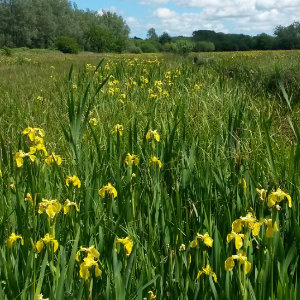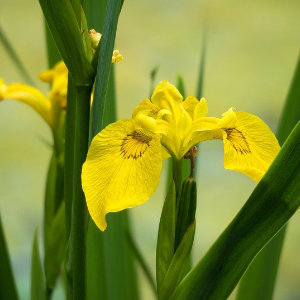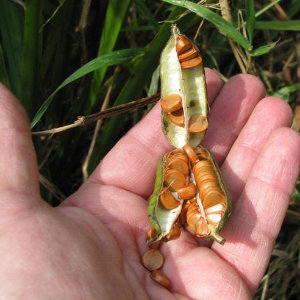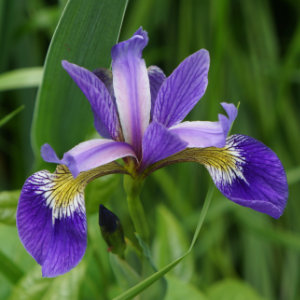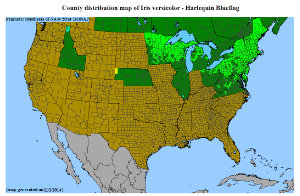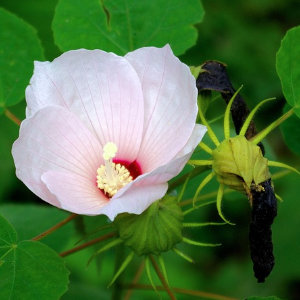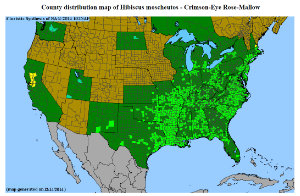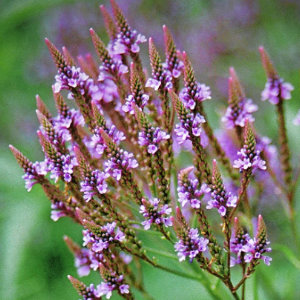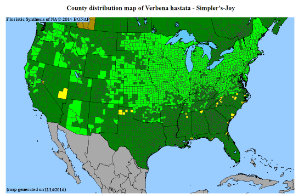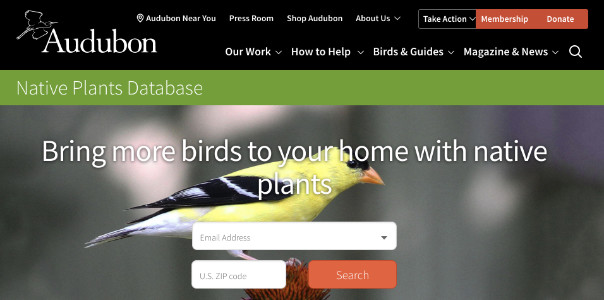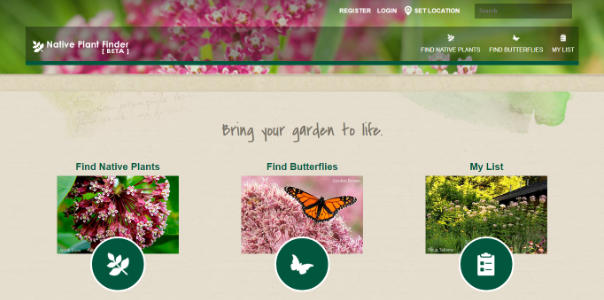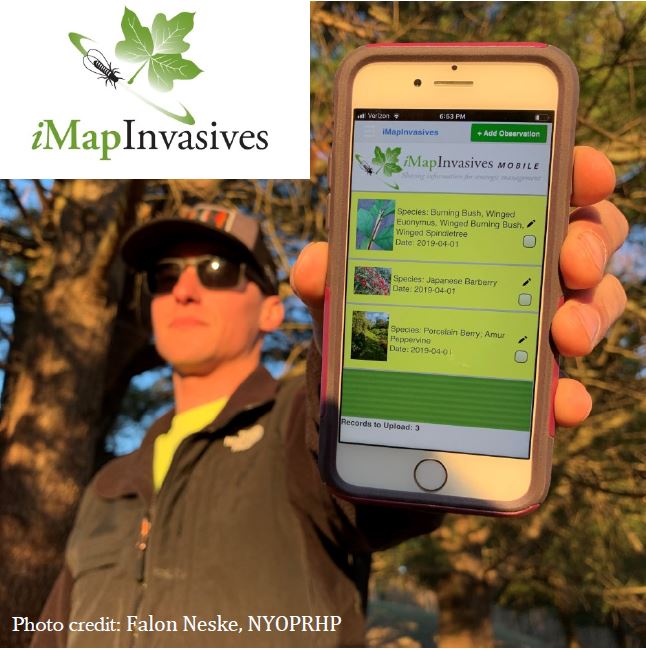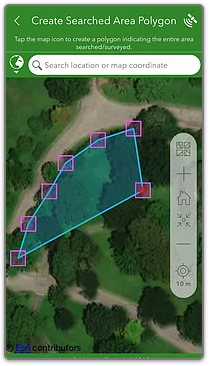Yellow Iris
Yellow iris (Iris pseudacorus) is an attractive water garden plant originally promoted for erosion control, ornamental value, and its ability to remove metals and nutrients from sewage treatment plant effluent. However, in wetland areas where it prefers to grow, this plant can outcompete important native vegetation, making it an undesirable choice to include in home landscapes.
- Credit: Jeremy Halls, “Thorpe Marshes Nature Reserve”, CC BY-SA 2.0
- Yellow Iris flower
- Credit: Leslie J. Mehrhoff, University of Connecticut, Bugwood.org
Identification
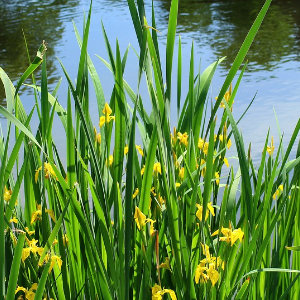
Yellow Iris clump
Yellow iris is a perennial plant that grows 3-4 feet tall and produces showy flowers that are cream to yellow in color. This plant blooms from May to July. Its long sword-like leaves are 1-3 feet in length, dark green to greenish-blue, and have a raised mid-rib. Yellow iris produces a three-sided seedpod that contains three rows of seeds on the inside. This wetland plant can be found growing along streams and ponds, in forested floodplains, and in freshwater and brackish marshes.
Yellow iris may be confused with cattails (Typha sp.) when not in flower and has similarities to other iris species like blue flag iris (Iris versicolor). However, the color of the blue flag iris flowers easily distinguishes it from yellow iris.
Additional information on how to identify yellow iris can be found online.
Ecological Threat
Yellow iris can grow in dense mats and exclude important native plants from wetlands and streamside habitats. Mats can trap sediments and alter a wetland by raising the topography. It can also clog wetlands, small streams, and block pipe intakes. Additionally, all parts of the plant are poisonous.
Yellow Flag Iris – Credit: Oregon Department of Agriculture
Control and Removal
If yellow iris is present on your property, consider removal and management options. The following resources provide valuable information and tips.
Identification Tips: Yellow Iris (Iris pseudacorus) – Credit: University of Minnesota AIS Detectors
Other management tips can be found at:
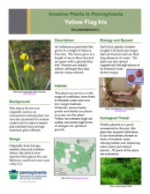 Download the Invasive Plants in Pennsylvania datasheet: Yellow Iris from the Pennsylvania Department of Conservation and Natural Resources.
Download the Invasive Plants in Pennsylvania datasheet: Yellow Iris from the Pennsylvania Department of Conservation and Natural Resources.
Plant Native Alternatives
*This list is not comprehensive, but rather provides a sampling of species available for purchase from retailers located in Pennsylvania and/or surrounding states. All native plant distribution maps (below) are provided by the Biota of North America Program.
- Credit: John Winder, “Iris versicolor (blue flag, wild iris, blue harlequin iris)”, CC BY-NC-ND 2.0
Blue Flag Iris (Iris versicolor)
Blue flag iris grows best in medium to wet soils and can be planted in up to 2-4” of shallow standing water. It can grow in full sun to part shade.
- Swamp Rose Mallow
Swamp Rose Mallow (Hibiscus moscheutos)
Swamp rose mallow is easily grown in a variety of soil conditions (average, medium or wet) and prefers to be in areas that receive full sun. This species is suggested for inclusion in rain gardens as it grows best in moist soils. Regular deep watering is advisable.
- Credit: Gene Wilburn, “Blue Vervain (Verbena hastata)”, CC BY-NC-ND 2.0
Blue Vervain (Verbena hastata)
Blue vervain is best grown in spaces that receive full sun. It can be grown in a variety of soil conditions, though prefers medium to wet locations.
Learn More and Take Action
Why are Native Plants Important?
Learn more about the importance of planting native plants by reviewing the following resources. And remember, planting even one native plant on your property is a tremendous benefit to wildlife and the environment!
Doug Tallamy Explains, “Why Native Plants?”
Credit: Catherine Zimmerman
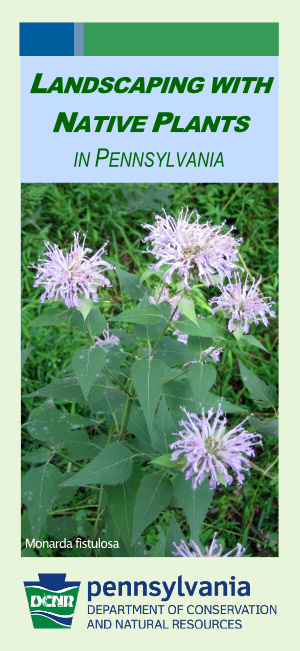
Landscaping with Native Plants in Pennsylvania
Credit: PA Department of Conservation and Natural Resources
Professor Doug Tallamy on Sustainable Landscaping
Credit: University of Delaware
Discover Native Plants.
Learn what plants are native to your area by using the National Wildlife Federation’s Native Plant Finder or the Audubon’s Native Plants Database. Both programs are easy to use - just type in your zip code and a list of native plants is provided to you.
Record Invasive Species Findings with iMapInvasives.
If you find invasive plants and animals in natural areas such as parks, forests, and meadows, please report them to iMapInvasives, an online tool used by natural resource professionals and citizen scientists to record locations of invasive species The iMapInvasives program is useful in understanding species distributions statewide and is used by land managers to prioritize locations to conduct treatment efforts. In Pennsylvania, the iMapInvasives program is administered by the Western Pennsylvania Conservancy and the Pennsylvania Natural Heritage Program and is financially supported by the Great Lakes Restoration Initiative. At the national level, iMapInvasives is administered by NatureServe.
A free registered user account is needed in order to contribute and view data in iMapInvasives. Register here.
How to create a presence record in iMapInvasives online (video)
Connect with Our Experts
Please direct any questions or comments regarding this species profile to Amy Jewitt, Invasive Species Coordinator, or Mary Walsh, Aquatic Zoology Coordinator.

